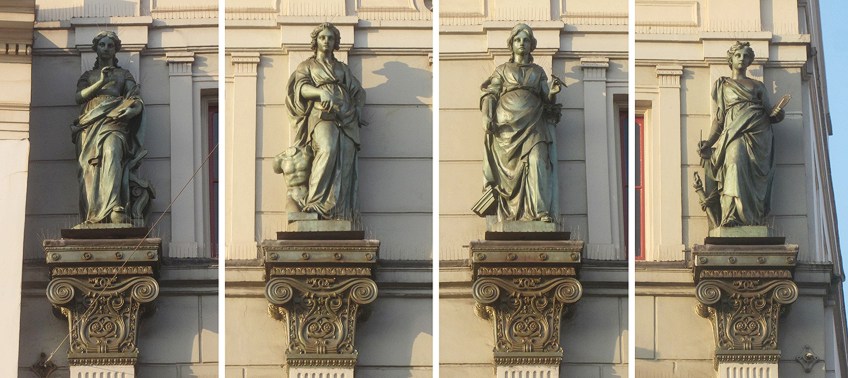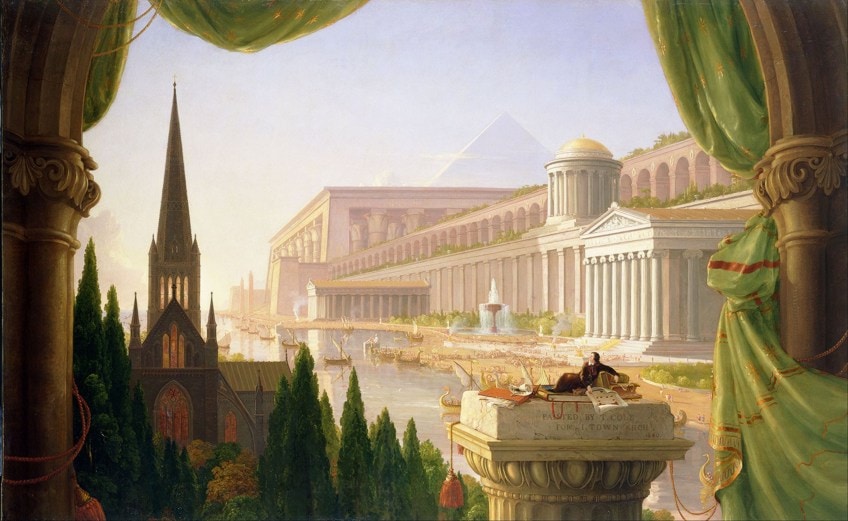Is Architecture Art? – Why Is Architecture Considered Art?
Is architecture art, and if so, why is architecture considered art? If you have ever seen the work of Antonio Gaudí, then it’s a good chance that you agree that artistic architecture exists. He is not the only example though, as there are many architects in movements such as Art Nouveau and Postmodernism that have created architecture artwork masterpieces. Let us explore the topic further and discuss a few art and architecture examples.
Is Architecture Art?
Architecture, being one of the classic fine arts disciplines, has long had a close relationship with the art world. What we refer to as architecture is the process of designing, planning, and constructing beautiful buildings.
Architectural works are typically recognized as cultural icons and works of art. Many classical structures include additional aesthetic features such as murals, or sculptures.
Despite being a well-established form of art, architecture does not fit many of the requirements that characterize fine art, making it an outsider in the art world. To understand the connection between art and architecture, let’s first discuss the two separately.
How Do We Define Art?
Art, as we know it, is extremely subjective. However, it is widely acknowledged that creative work includes the representation of technical skill, beauty, emotive ability, or abstract concepts through creative or imaginative capability. There is no widely recognized definition of art, and ideas of what defines art have developed and are subject to constant discussion.
The three classic branches of visual art are painting, sculpture, and architecture.
A broader definition of “the arts” encompasses theater, music, and other performing arts, as well as literature, cinema, and other visual content. Architecture is a type of fine art, commonly known as the “high arts”. These fine arts have been regarded as the pinnacle of aesthetic expression for a long time. Because they were originally developed for more utilitarian uses, crafts, and advertising are not considered fine art. Fine art is created only for the purpose of gratifying the eye.

How Do We Define Architecture?
Architecture is the art and technique of planning and creating buildings that have an artistic component rather than focusing purely on technical skills. Architectural design is employed to suit both practical and aesthetic objectives, thereby fulfilling both technical and creative objectives. Architecture, under this interpretation, does not fall within the category of fine art because it provides a useful purpose.
Nevertheless, not all constructions are architecturally constructed; so, hiring an architect means prioritizing aesthetics over pure functionality.
How Do Architecture and Art Differ?
There are parallels and differences between architecture and art. Art is a creative activity that is not motivated by necessity. Art may take many forms, such as musical innovation, sculpting shapes, or creating photorealistic artwork. Architecture is typically a three-dimensional physical construct. While art represents creative freedom and breaking the norms, architecture always has certain practical constraints.
In comparison to stiff and uncompromising architecture, art is abstract in its essence.
How Are Architecture and Art Similar?
Both art and architecture are designed with the same basic organizational principles, aesthetically based elements, and perceptual interaction in mind. When we look at art and architecture history, we notice that many individuals were both architects and artists as there is much overlap between the two principles. Architecture and art are both culturally and historically significant.
They are simultaneously emotive and expressive.
The artist’s “shaping” element is presented to the audience in order to visually communicate a complex mixture of thoughts. Architects create practical or useable spaces, yet their architectural creations are significant in their own right. Reliefs, sculptures, murals, and three-dimensional artworks are all directly related to architecture. All of these creative forms are constrained by factors like balance, space, gravity, and so on.
Art is a medium of expression that can be interpreted in many ways and shared, while architecture is a mix of art, technology, and structure. Architecture and art have frequently collaborated in a complementary manner. Structures were adorned with floral patterns and scrolled columns beginning in early Roman times and continuing through the Art Nouveau architectural style with highly ornate and organic characteristics.
Humans engage in and perceive the environment through connecting to things as they navigate about them.
To create space that optimizes the way we integrate into that environment is an artform all on its own. Architecture is closely related to paintings, sculptures, calligraphy, and other kinds of art. As a result, Western architecture has been termed the “mother of the arts.”
There is no place to show other artworks without architecture, and many classical artworks were intended and made in unison with the structure to be appreciated as a whole.
| Art | Architecture | |
| How Is It Paid For? | Commission or self | Commission |
| Do You Need to Study? | Not necessarily | Preferably |
| Is It Creative or Technical? | Mostly creative | Mostly technical |
Is Architecture an Art or Craft?
Crafts are classified as commercial arts. Metalwork, ceramics, glasswork, and jewelry are just a handful of the projects regarded as crafts. Painting, architecture, and sculpture, on the other hand, are examples of high art forms. Art is an activity that expresses emotions and concepts. Emotions are conveyed in art; but, in a craft, emotions come second to function. Architecture is classified as a sort of art, yet it shares many characteristics with crafts.
Beyond imagination and sketching, the tools are the experienced artisans with whom we collaborate, turning sculpted metal, wood, marble, and glassware into shared creations.

Artistic Architecture Movements
There have been periods in history where architecture has been particularly dull and stiff. These purely utilitarian structures were devoid of any life or vibrancy and were created specifically to perform some function, usually governmental. Sometimes the style was dull because it was created for some boring administrative office purpose, other times it was the desire of the architects themselves to create modernist structures that were all sleek and shiny and minimal, yet featured no decorations at all.
Usually, straight after such periods, there would be a counter-movement that would arise to challenge the stifling styles of the status quo and create something invigorating and fresh.

This was the case with Postmodernism, for example. Whereas the Modernist building had been all stuffy and austere, the Postmodernists wanted to create something new, yet that also incorporated elements of the past – something which the modernists had not done.
For many designers, creating architecture artworks meant creating spaces that expressed the character of the people and the environment around them.

This meant adding touches of color and shapes that were part of the local culture, or a combination of styles inspired by architectural designs from around the world. Another movement that fully embraced artistic architecture was the Art Nouveau movement. Whereas many preceding styles were occupied with hard and sharp angles and minimal embellishments, Art Nouveau was all about curves, natural shapes, and asymmetry. The irregular shapes of the buildings were also a characteristic of Postmodernist architecture.
Debates about what constitutes art are as old as time, and the definition keeps changing. For many ancient people, the objects they created were functional yet were often adorned beautifully. However, they did not consider it art, just a way of living. So too do architects take something functional and beautify it so that it can be enjoyed on multiple levels beyond mere survival. When we ask ourselves “Is architecture art?” we need to take into account the various principles required to design a building. Even the very first step – the design element – is largely an artistic effort. In order for a building to be created, it must first be imagined, and then captured on paper – these are all artistic in essence too. As with all things, art is in the eye of the beholder, and not only does it depend on who views it, but also the intention of the person who created it. Every principle has examples of people who simply meet the requirements, and those who lift the discipline to greater heights, by adding something unique, creative, and purposeful.
Frequently Asked Questions
Why Is Architecture Considered Art?
It is not only considered art, but it is regarded as the master art form by many. It requires so many disciplines to design a structure, and most of those steps are intrinsically artistic. From the internal conception of an idea, to mapping out the plan, to executing it in real life – every phase requires creative decision-making. It requires both technical prowess, intelligence, and creativity – buildings need to be structurally sound as well as enjoyable to interact with on a daily basis.
What Are a Few Art and Architecture Examples?
To compare art and architecture is silly when you consider how many creative individuals were both artists and architects. Just think of Giovanni Lorenzo Bernini, Le Corbusier, Giorgio Vasari, Mies Van Der Rohe, Michelangelo di Lodovico Buonarroti Simoni, Giulio Romano, Frank Gehry, Santiago Calatrava, Frank Lloyd Wright, and you will have an idea of how many famous artists were also architects. The same principles apply to both fields, so there are bound to be plenty of crossovers. Artistic architecture is the synthesis of multiple techniques and principles, combining centuries of methods and concepts from throughout history. That is why all the major movements affected both art and architecture.
Justin van Huyssteen is a freelance writer, novelist, and academic originally from Cape Town, South Africa. At present, he has a bachelor’s degree in English and literary theory and an honor’s degree in literary theory. He is currently working towards his master’s degree in literary theory with a focus on animal studies, critical theory, and semiotics within literature. As a novelist and freelancer, he often writes under the pen name L.C. Lupus.
Justin’s preferred literary movements include modern and postmodern literature with literary fiction and genre fiction like sci-fi, post-apocalyptic, and horror being of particular interest. His academia extends to his interest in prose and narratology. He enjoys analyzing a variety of mediums through a literary lens, such as graphic novels, film, and video games.
Justin is working for artincontext.org as an author and content writer since 2022. He is responsible for all blog posts about architecture, literature and poetry.
Learn more about Justin van Huyssteen and the Art in Context Team.
Cite this Article
Justin, van Huyssteen, “Is Architecture Art? – Why Is Architecture Considered Art?.” Art in Context. September 22, 2022. URL: https://artincontext.org/is-architecture-art/
van Huyssteen, J. (2022, 22 September). Is Architecture Art? – Why Is Architecture Considered Art?. Art in Context. https://artincontext.org/is-architecture-art/
van Huyssteen, Justin. “Is Architecture Art? – Why Is Architecture Considered Art?.” Art in Context, September 22, 2022. https://artincontext.org/is-architecture-art/.









